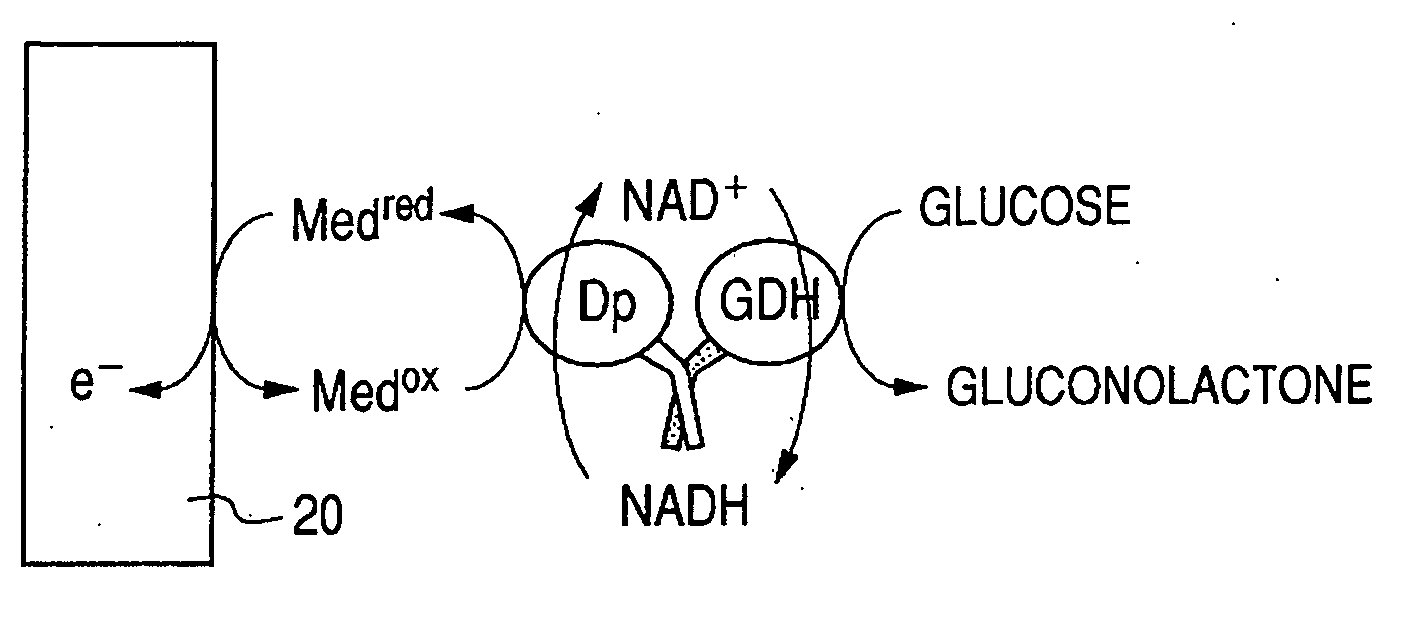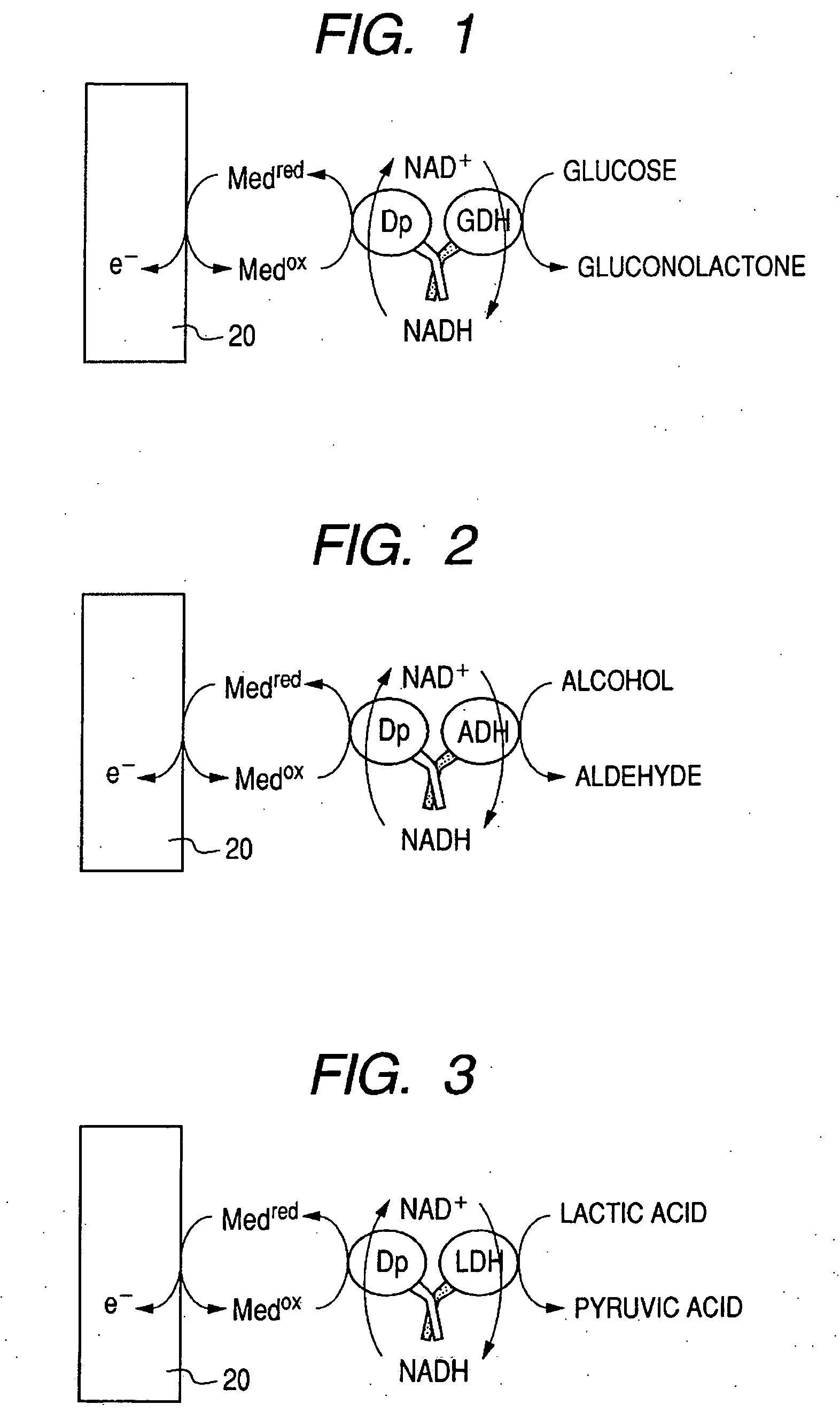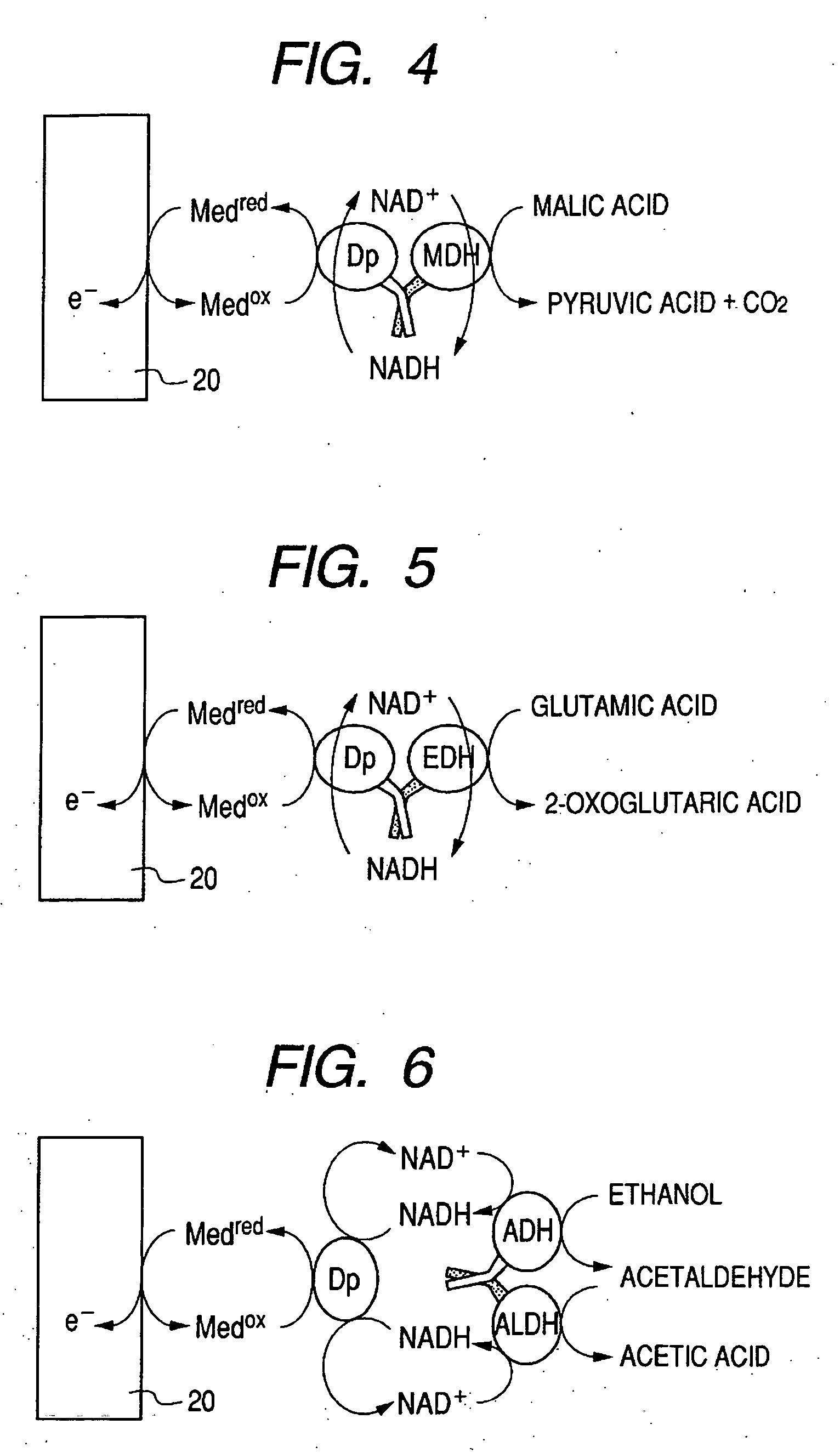Enzyme electrode
- Summary
- Abstract
- Description
- Claims
- Application Information
AI Technical Summary
Benefits of technology
Problems solved by technology
Method used
Image
Examples
example 10
(Example 10) Alcohol Sensor
[0289] A conductive base member 20 is formed by glassy carbon of a diameter of 3 mm. On the conductive base member 20, an associated protein (His-sceADH-Fos / ppuDp-Jun) of alcohol dehydrogenase (sceADH) derived from Saccharomyces cerevisiae in Example 9 and diaphorase (ppuDp) derived from Pseudomonas putida, and a ferrocene-bonded polyallylamine (Fc-PAA) are immobilized by crosslinking by poly(ethylene glycol) diglycigyl ether (PEGDE). Components immobilized on the enzyme electrode have the following formulation:
[0290] His-sceADH-Fos / ppuDp-Jun (sceADH: 0.3 units, ppuDp: 0.6 units)
[0291] Fc-PAA: 161g
[0292] PEGDE: 10 μg
[0293] This enzyme electrode is used as the reaction electrode 4 in FIG. 10 to construct an alcohol sensor. Also the sample solution 3 is formed by a 0.1M PIPES-NaOH aqueous buffer solution (pH 7.5) containing alcohol of a predetermined concentration and NAD of 1 mM. A potential of 300 mV is applied to the reaction electrode 4 with respect ...
example 42
(Example 42) Alcohol Sensor
[0483] A conductive base member 20 is formed by glassy carbon of a diameter of 3 mm. On the conductive base member 20, an associated protein (His-sceADH-Dzip1 / goxALDH-Dzip2) of alcohol dehydrogenase (sceADH) derived from Saccharomyces cerevisiae in Example 41 and aldehyde dehydrogenase (goxALDH) derived from Gluconobacter oxydans, a diaphorase (ppuDp) derived from Pseudomonas putida, and a ferrocene-bonded polyallylamine (Fc-PAA) are immobilized by crosslinking by poly(ethylene glycol) diglycigyl ether (PEGDE). Components immobilized on the enzyme electrode have the following formulation:
[0484] His-sceADH-Dzip1 / goxALDH-Dzip2 (sceADH: 0.3 units, goxALDH: 0.6 units)
[0485] ppuDp: 0.6 units
[0486] Fc-PAA: 16 μg
[0487] PEGDE: 10 μg
[0488] This enzyme electrode is used as the reaction electrode 4 in FIG. 10 to construct an alcohol sensor. Also the sample solution 3 is formed by a 0.1M PIPES-NaOH aqueous buffer solution (pH 7.5) containing alcohol (ethanol) of ...
example 58
(Example 58) Alcohol Sensor
[0610] Structure of an enzyme electrode is shown in FIG. 8. A conductive base member 20 is formed by glassy carbon of a diameter of 3 mm. On the conductive base member 20, an associated protein (His-sceADH-Dzip3 / goxALDH-Dzip4 / ppuDp-Dzip5) of alcohol dehydrogenase (sceADH) derived from Saccharomyces cerevisiae in Example 57, aldehyde dehydrogenase (goxALDH) derived from Gluconobacter oxydans, and diaphorase (ppuDp) derived from Pseudomonas putida, and a ferrocene-bonded polyallylamine (Fc-PAA) are immobilized by crosslinking by PEGDE. Components immobilized on the enzyme electrode have the following formulation:
[0611] His-sceADH-Dzip3 / goxALDH-Dzip4 / ppuDp-Dzip5 (sceADH: 0.3 units, goxALDH: 0.6 units, and ppuDp: 0.6 units)
[0612] Fc-PAA: 16 μg
[0613] PEGDE: 10 μg
[0614] This enzyme electrode is used as the reaction electrode 4 in FIG. 10 to construct an alcohol sensor. Also the sample solution 3 is formed by a 0.1M PIPES-NaOH aqueous buffer solution (pH 7.5)...
PUM
| Property | Measurement | Unit |
|---|---|---|
| Electrical conductor | aaaaa | aaaaa |
| Efficiency | aaaaa | aaaaa |
Abstract
Description
Claims
Application Information
 Login to View More
Login to View More - R&D
- Intellectual Property
- Life Sciences
- Materials
- Tech Scout
- Unparalleled Data Quality
- Higher Quality Content
- 60% Fewer Hallucinations
Browse by: Latest US Patents, China's latest patents, Technical Efficacy Thesaurus, Application Domain, Technology Topic, Popular Technical Reports.
© 2025 PatSnap. All rights reserved.Legal|Privacy policy|Modern Slavery Act Transparency Statement|Sitemap|About US| Contact US: help@patsnap.com



